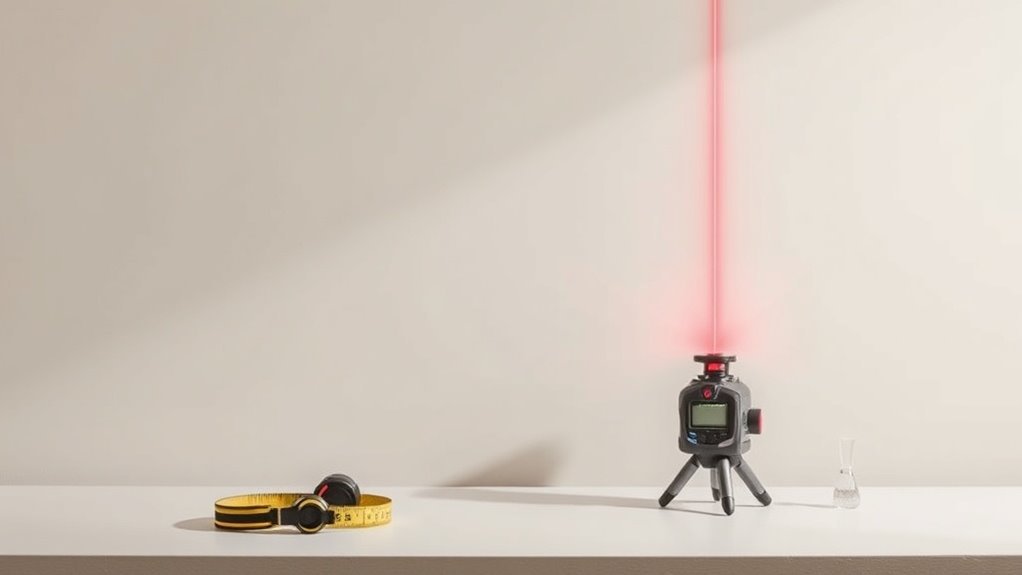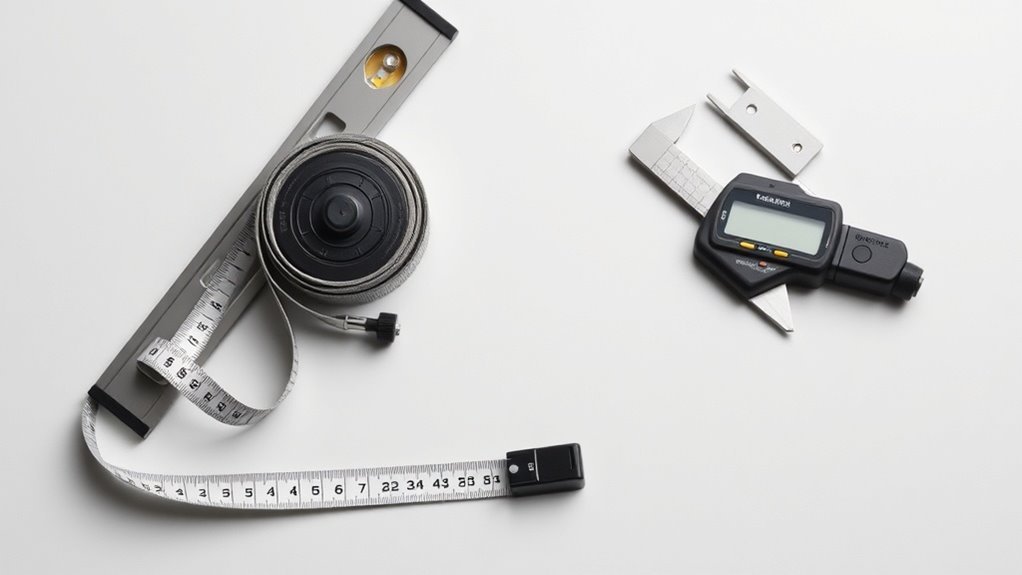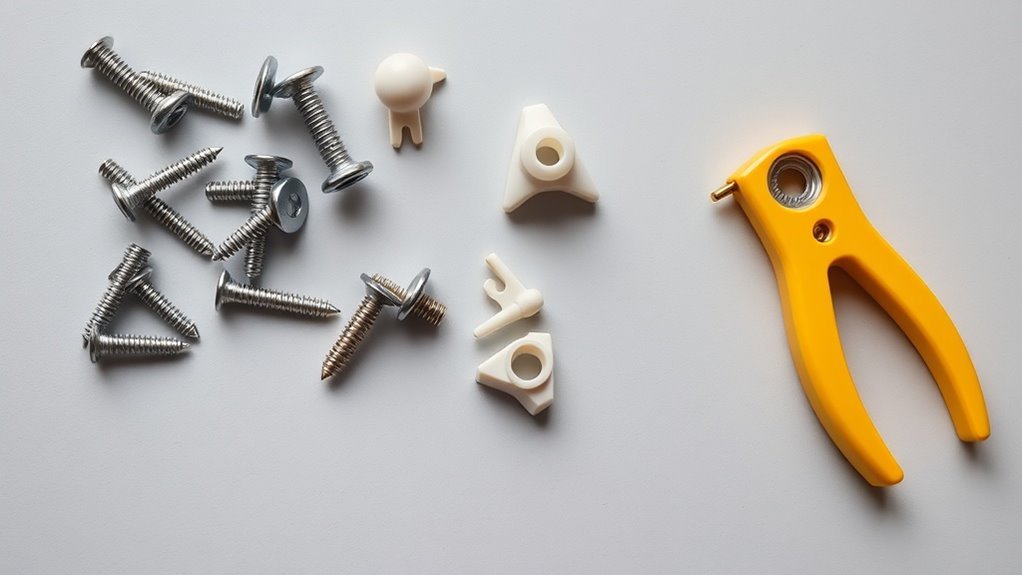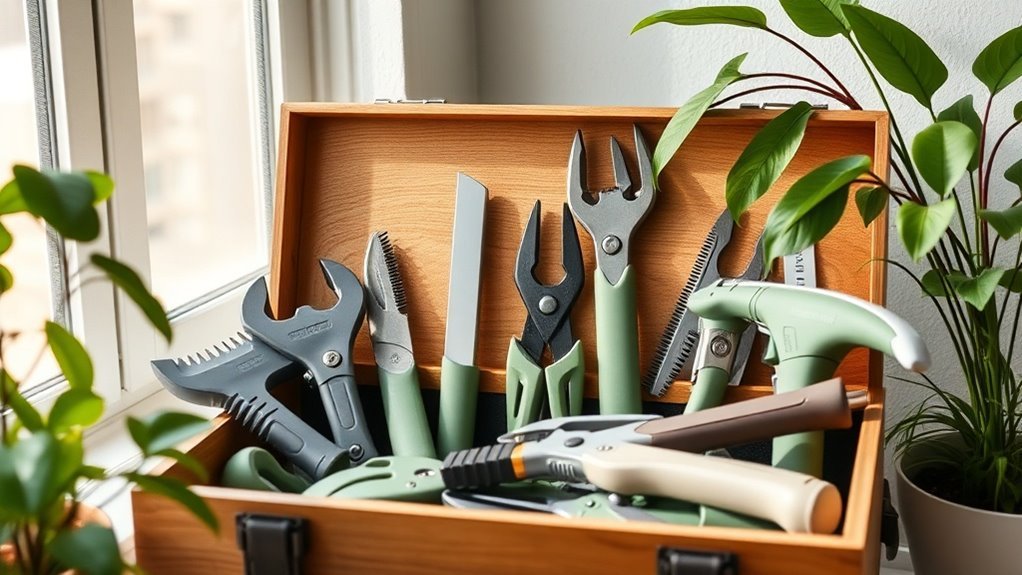How to Use a Laser Level for Perfect Alignment

To use a laser level for perfect alignment, start by clearing your workspace and ensuring it’s well-lit. Set your laser on a stable surface at the desired height and choose the right settings for horizontal or vertical lines. Adjust until the beam is true, then mark where it intersects surfaces. Keep it calibrated for accuracy and be mindful of common pitfalls, like working in bright sunlight. Keep going to uncover more tips for effective usage.
Key Takeaways
- Clear the workspace of debris and ensure adequate lighting for accurate visibility of the laser beam.
- Set up the laser level on a stable surface and align it to the intended measurement reference point.
- Use bubble levels to ensure the laser beam is perfectly horizontal or vertical before marking.
- Mark intersections where the laser hits for precise alignment, double-checking measurements with tape measures or speed squares.
- Regularly recalibrate the level and maintain the device by keeping it clean and storing it properly after each use.
Understanding the Basics of Laser Levels
Laser levels are vital tools for achieving precise alignments in various construction and DIY projects. They use a laser beam to create a level line across surfaces, making it easier to guarantee accuracy when installing shelves, tiles, or framing walls.
Understanding the basic components is fundamental. Most laser levels feature a laser emitter that projects the beam and a receiver that detects it. You’ll often find settings for different modes, such as horizontal, vertical, or plumb lines.
Understanding the key components of laser levels—like the emitter and receiver—is crucial for accurate measurements and effective project execution.
It’s important to guarantee the level is calibrated correctly; otherwise, your measurements could be off. Using a tripod can also enhance stability and accuracy, especially when working in larger spaces. Additionally, these tools benefit from the advancements in laser distance measuring technology, which enhance precision and efficiency in your projects.
Familiarizing yourself with these basics will greatly enhance your project’s efficiency and outcome.
Types of Laser Levels

When it comes to choosing the right laser level for your project, it’s important to know the different types available. The most common types are point, line, and rotary laser levels.
Point laser levels project a single dot, perfect for marking elevation points. Line laser levels, on the other hand, project a straight line, ideal for aligning walls or fixtures. Finally, rotary laser levels rotate a beam 360 degrees, making them great for larger areas or outdoor projects.
If you’re doing interior work, a line level might be your best bet. For extensive outdoor tasks, consider a rotary level for its range. Understanding these options will help you select the right laser level for your specific needs, ensuring accuracy in your work.
Preparing Your Workspace
Before starting your laser level project, it’s essential to prepare your workspace to guarantee accuracy and efficiency. Clear the area of unnecessary items and debris to uphold a safe working environment. Make sure you have sufficient lighting, as poor visibility can lead to errors.
Next, organize your tools and materials. Here’s a quick checklist to keep everything in check:
| Task | Status |
|---|---|
| Clear the workspace | ✔ Completed |
| Check lighting | ✔ Sufficient |
| Gather tools | ✔ Ready to go |
Finally, make sure your surface is stable. A solid surface minimizes vibrations, allowing for precise measurements. Additionally, wearing appropriate safety gear is crucial to protect yourself while using tools. With a well-prepared workspace, you’re now ready to tackle your laser level project efficiently!
Setting Up Your Laser Level
To guarantee accurate results, it’s essential to set up your laser level correctly.
First, choose a stable surface to place the level, keeping it away from vibrations or obstacles. If you’re using a tripod, adjust the legs to make certain it’s level before securing the laser unit.
Next, adjust the height so the beam aligns with your measurement reference point. If you’ve got a self-leveling model, turn it on and give it a moment to calibrate automatically. For manual levels, adjust the bubble vial until it’s centered.
Be certain the laser’s beam isn’t obstructed and is visible in your workspace. By following these steps, you’re on your way to achieving precise measurements for your project. Proper setup and alignment are crucial, as even minor miscalculations can lead to significant errors in the final result, highlighting the importance of using spirit levels effectively.
Aligning Horizontal Lines
Once you’ve set up your laser level, it’s time to focus on aligning horizontal lines.
This step is essential for ensuring your measurements are accurate and your project looks professional.
Let’s explore how to achieve precision in your layout.
Setting Up the Laser
Setting up your laser level for aligning horizontal lines is essential for achieving accurate results in your project. First, pick a stable location for the laser, ensuring it’s free from vibrations or disturbances.
Once you’ve positioned it, adjust the level until the beam is perfectly horizontal. Most laser levels will have a built-in bubble level to aid with this step. If you’re working on uneven ground, use adjustable tripod legs for ideal stability.
After you’ve secured the laser, turn it on and let it self-level if it has that feature. Make sure the laser beam is projected straight across your workspace, marking your desired height.
This clear and precise setup will make your horizontal alignment tasks much easier and effective.
Measuring With Precision
Achieving precise measurements with a laser level can considerably streamline your project, especially when aligning horizontal lines.
Start by setting up your laser level on a stable surface or tripod, making certain it’s perfectly level. Once you activate the laser, watch for the beam to project a straight line across your workspace.
To measure accurately, use a tape measure or a speed square to reference the laser line against your intended height or line.
Mark the points where the laser intersects your wall or surface; this is your guide. For long distances, you might need to use multiple measuring points to maintain consistency.
With a little practice, you’ll find that using a laser level makes achieving perfect alignments easier than ever.
Aligning Vertical Lines
To effectively align vertical lines with a laser level, simply position the tool against a wall or other vertical surface. Turn it on, and you’ll see a straight laser line projected onto your surface.
Make certain to adjust the height to match the area where you want to align your vertical lines. If you’re working with multiple lines, check that everyone’s level at the same height for consistency.
Use a pencil or small mark to note where the laser hits. To confirm accuracy, step back and visually verify that the lines are straight.
Don’t forget to keep the laser level steady during your measurements. This method guarantees that everything appears perfectly aligned without any guesswork!
Using Laser Levels for Tiling
When you’re laying tiles, a laser level can be your best friend.
First, you’ll need to set up the level accurately, which will help create a strong foundation.
After that, you can easily align your tile rows for a perfect finish.
Setting Up the Level
Using a laser level for tiling can dramatically improve your results, especially if you take the time to set it up correctly.
Start by finding a stable surface to place your laser level, ensuring it’s free from vibrations. Next, power on the device and select a horizontal or vertical beam based on your tiling layout. If it’s a self-leveling model, give it a moment to adjust.
Use a measuring tape to determine the height or baseline, marking these points on the wall or floor. Adjust the level until the laser line aligns with your marks.
Finally, secure the level, ensuring it won’t shift during the tiling process. A solid setup will keep everything precise as you start laying tiles.
Aligning Tile Rows
As you prepare to lay your tiles, aligning the rows correctly becomes essential for a professional finish.
Start by setting up your laser level at a height that’s convenient for your tiling area. Once you’ve established the height, turn on the laser and project a level line across your wall or floor. This line acts as your guide for the first row of tiles.
Begin placing your tiles along the laser line, making certain they stay aligned as you work. Keep an eye on the alignment by periodically checking against the laser to catch any deviations early.
If needed, adjust the tiles gently, maintaining a good grout space for a clean look. Following these steps will guarantee your tile rows are perfectly aligned.
Common Mistakes to Avoid
Although laser levels are designed to make your projects easier, it’s easy to make mistakes that can lead to inaccurate measurements. One common error isn’t ensuring your level is stable. If it’s on an uneven surface, your readings will be off.
Ensure your laser level is stable; uneven surfaces can lead to inaccurate measurements.
Additionally, be mindful of the laser’s visibility; bright sunlight can obscure the beam, so try to work in shaded areas when possible.
Another mistake is neglecting to check your reference point; if it’s misplaced, every measurement taken will be flawed.
Finally, don’t forget to recalibrate your level regularly, as it can drift over time.
Maintenance and Care for Your Laser Level
To guarantee your laser level remains accurate and reliable, regular maintenance and care are key. Start by keeping it clean; wipe the lens and casing to remove dust and debris. Always store your level in a protective case to prevent damage. Check the battery regularly, replacing it when it shows signs of low power. Calibration should be performed periodically; follow the manufacturer’s instructions to assure precision. Finally, avoid exposing your level to extreme temperatures or moisture.
| Maintenance Task | Frequency | Notes |
|---|---|---|
| Clean lens and casing | After each use | Use a soft, lint-free cloth |
| Check battery | Weekly | Replace if low |
| Calibration | Monthly | Follow manufacturer guidelines |
| Inspect for damage | Before each use | Look for cracks or wear |
| Store | After each use | Use a protective case |
Questions
Can I Use a Laser Level Outdoors?
Yes, you can use a laser level outdoors, but make certain it’s bright enough for visibility. Consider its range and the sun’s glare, as these factors can affect accuracy. Shielding it from wind helps too.
How Do I Troubleshoot a Malfunctioning Laser Level?
If your laser level’s a ship lost at sea, check the batteries first; they’re often the culprit. Then, inspect for damage. If all else fails, recalibrate it and seek help from the manual or support.
What Safety Precautions Should I Take When Using a Laser Level?
When using a laser level, wear safety glasses to protect your eyes, avoid pointing the laser at people or reflective surfaces, and guarantee it’s placed on stable ground to prevent accidental movement or falling.
Can Laser Levels Be Used for Landscaping Projects?
Yes, laser levels can definitely be used for landscaping projects. They help guarantee precise grading, alignment of features, and accurate placement of plants or hardscapes, making your outdoor space look professional and well-planned.
How Do I Calibrate My Laser Level?
To calibrate your laser level, you should place it on a stable surface, turn it on, and then adjust the leveling feet until the beam aligns perfectly with a reference point or line.
Conclusion
Using a laser level can transform your projects from ordinary to extraordinary, creating flawless alignments that make everything look like it was crafted by a master artisan. By understanding the basics and following the simple steps outlined, you’ll avoid common pitfalls and elevate your work to new heights. Remember, a little practice goes a long way, and soon, you’ll wield your laser level like a wizard casting a spell of precision in your workspace!






